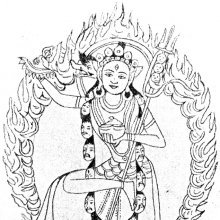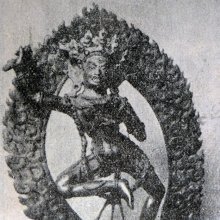Yuganaddha: 6 definitions
Introduction:
Yuganaddha means something in Buddhism, Pali, Hinduism, Sanskrit. If you want to know the exact meaning, history, etymology or English translation of this term then check out the descriptions on this page. Add your comment or reference to a book if you want to contribute to this summary article.
Images (photo gallery)
In Buddhism
Theravada (major branch of Buddhism)
Source: Pali Kanon: Manual of Buddhist Terms and Doctriness. samatha-vipassanā, last paragraph.
Source: Pali Kanon: Pali Proper NamesYuganaddha (or Yuganandha):—Ananda tells the monks at Ghositarama, in Kosambi, that those who have attained arahantship have done so in one of four ways (Cf. Yuganandhasutta).
Theravāda is a major branch of Buddhism having the the Pali canon (tipitaka) as their canonical literature, which includes the vinaya-pitaka (monastic rules), the sutta-pitaka (Buddhist sermons) and the abhidhamma-pitaka (philosophy and psychology).
Mahayana (major branch of Buddhism)
Source: academia.edu: A Study and Translation of the GaganagañjaparipṛcchāYuganaddha (युगनद्ध) refers to the “unification (of insight and skillful means)”, according to the Gaganagañjaparipṛcchā: the eighth chapter of the Mahāsaṃnipāta (a collection of Mahāyāna Buddhist Sūtras).—Accordingly, “How, son of good family, does the Bodhisattva obtain the mastery (vaśitāprāpta) in the arising of birth and death? When the Bodhisattva is endowed with twelve dharmas, son of good family, he attains the mastery in the arising of birth and death. What are the twelve? [...] (5) he unifies insight and skillful means (prajñopāya-yuganaddha); (6) he attains unhindered supernormal knowledge; (7) he reflects on non-origination and non-existence; (8) he is born according to his will and fulfills his vows; [...]”.

Mahayana (महायान, mahāyāna) is a major branch of Buddhism focusing on the path of a Bodhisattva (spiritual aspirants/ enlightened beings). Extant literature is vast and primarely composed in the Sanskrit language. There are many sūtras of which some of the earliest are the various Prajñāpāramitā sūtras.
Tibetan Buddhism (Vajrayana or tantric Buddhism)
Source: Google Books: Medieval Rule in TibetYuganaddha (युगनद्ध) is the name of a Dharmapāla displayed on the sixth tier of the bkra shis sgo mang Stupa erected by Kun dga’ rin chen.—The outline of the sixth tier shows eight Nāgarāja located at the quarters. [...] The bkra shis sgo mang Stupa erected by Kun dga’ rin chen at ’Bri gung has, however, some significant changes which is of importance regarding surviving fragments. He introduced some new Dharmapālas in the iconographic programme of the Stupa he commissioned: [e.g., Yuganaddha Mahākāla].

Tibetan Buddhism includes schools such as Nyingma, Kadampa, Kagyu and Gelug. Their primary canon of literature is divided in two broad categories: The Kangyur, which consists of Buddha’s words, and the Tengyur, which includes commentaries from various sources. Esotericism and tantra techniques (vajrayāna) are collected indepently.
Languages of India and abroad
Pali-English dictionary
Source: BuddhaSasana: Concise Pali-English Dictionaryyuganaddha : (adj.) congruous; harmonious; connected to a yoke.

Pali is the language of the Tipiṭaka, which is the sacred canon of Theravāda Buddhism and contains much of the Buddha’s speech. Closeley related to Sanskrit, both languages are used interchangeably between religions.
Sanskrit dictionary
Source: DDSA: Paia-sadda-mahannavo; a comprehensive Prakrit Hindi dictionary (S)Yuganaddha (युगनद्ध) in the Sanskrit language is related to the Prakrit word: Juaṇaddha.
Sanskrit, also spelled संस्कृतम् (saṃskṛtam), is an ancient language of India commonly seen as the grandmother of the Indo-European language family (even English!). Closely allied with Prakrit and Pali, Sanskrit is more exhaustive in both grammar and terms and has the most extensive collection of literature in the world, greatly surpassing its sister-languages Greek and Latin.
See also (Relevant definitions)
Partial matches: Naddha, Yuga.
Starts with: Yuganaddhasutta.
Full-text: Bojjhangakatha, Juanaddha, Yuganandha, Yuganandhasutta, Yuganaddhasutta, Patisambhidamagga, Vajravarahi, Samatha Vipassana.
Relevant text
Search found 4 books and stories containing Yuganaddha, Yuga-naddha; (plurals include: Yuganaddhas, naddhas). You can also click to the full overview containing English textual excerpts. Below are direct links for the most relevant articles:
Guide to Tipitaka (by U Ko Lay)
Part 12 - Patisambhida Magga Pali < [Chapter VIII - Khuddaka Nikaya]
Blue Annals (deb-ther sngon-po) (by George N. Roerich)
Chapter 6 - First incarnation series (viii): de bzhin gshegs pa (Karmapa V) < [Book 8 - The famous Dakpo Kagyü (traditions)]
Chapter 29 - Sonam Gyatso (vii): Labors for the doctrine < [Book 10 - The Kālacakra]
Chapter 2 - Guhyasamāja Marpa system < [Book 8 - The famous Dakpo Kagyü (traditions)]
The Indian Buddhist Iconography (by Benoytosh Bhattachacharyya)
Maha Prajnaparamita Sastra (by Gelongma Karma Migme Chödrön)
Bhūmi 7: the far-gone ground (dūraṃgamā / dūraṅgamā) < [Chapter XX - (2nd series): Setting out on the Mahāyāna]

